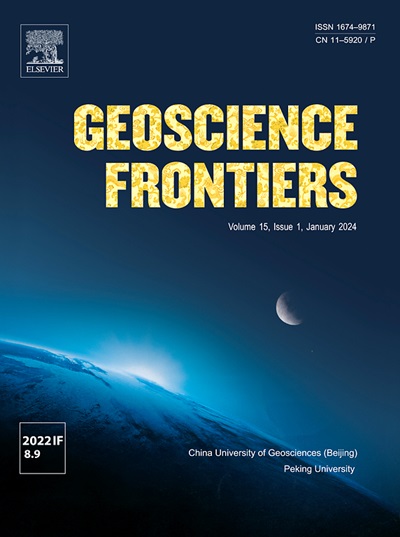Metamorphic evolution of blueschists in the Heilongjiang Complex: Implications for the subduction history of the Mudanjiang Ocean
IF 8.9
1区 地球科学
Q1 GEOSCIENCES, MULTIDISCIPLINARY
引用次数: 0
Abstract
The Heilongjiang Complex in northeast China (NE China) separates the Jiamusi and Songliao blocks and marks the suture zone of the former Mudanjiang Ocean, as evidenced by a variety of oceanic basalt-derived blueschists. Understanding the closure history of the Mudanjiang Ocean is crucial to unravelling the tectonic transition from the final amalgamation of the Central Asian Orogenic Belt (CAOB) to the onset of the Paleo-Pacific subduction. In this study, we investigate epidote-ferroglaucophane (Ep-Fgl) and garnet-ferrobarroisite (Grt-Fbrs) schists from the Yilan area of the Heilongjiang Complex through petrological, mineralogical, thermodynamic modelling, whole-rock geochemical, and geochronological analyses. The Ep-Fgl schists preserve a peak assemblage of ferroglaucophane + epidote + chlorite + clinopyroxene + phengite + titanite with peak P–T conditions of 13.5–15.8 kbar and 458–495 °C. On the other hand, the Grt-Fbrs schists exhibit a peak assemblage of garnet + glaucophane/ferroglaucophane + lawsonite + chlorite + phengite + rutile ± clinopyroxene ± titanite, deriving peak P–T conditions of 16.4–18.3 kbar and 457–475 °C. Both types of schist record similar clockwise P–T paths, with three metamorphic stages: a peak epidote-to-lawsonite blueschist-facies stage, a post-peak decompression stage in the epidote amphibolite-facies, and a late greenschist-facies overprint stage. The Ep-Fgl schists display alkaline OIB-like geochemical affinities, while the Grt-Fbrs schists show tholeiitic MORB-like characteristics, suggesting that the protoliths represent fragments of the Mudanjiang oceanic crust. Magmatic zircon grains from Ep-Fgl schists yield protolith ages of 276 ± 1 Ma and 280 ± 1 Ma, whereas zircon of Grt-Fbrs schists document protolith ages of 249 ± 2 Ma and 248 ± 2 Ma, indicating that the Mudanjiang Ocean existed since at least the early Permian. Reconstruction of the metamorphic P–T evolution, combined with previous magmatic and metamorphic age data from rocks of the Heilongjiang Complex and of adjacent tectonic units suggests that the subduction and eventual closure of the Mudanjiang Ocean occurred between the late Triassic and middle Jurassic, driven by a regional stress regime shift caused by the westward subduction of the Paleo-Pacific Plate beneath Eurasia.

黑龙江杂岩蓝片岩变质演化:对牡丹江洋俯冲史的启示
中国东北的黑龙江杂岩将佳木斯和松辽地块分隔开来,标志着前牡丹江洋的缝合带,各种洋玄武岩蓝片岩的形成证明了这一点。了解牡丹江洋的闭合历史对于揭示中亚造山带最终合并到古太平洋俯冲开始的构造转变至关重要。本文通过岩石学、矿物学、热力学模拟、全岩地球化学和年代学分析,对黑龙江杂岩体宜兰地区绿帘铁-铁-铁榴石片岩(Ep-Fgl)和石榴石-铁-钡石片岩(Grt-Fbrs)进行了研究。Ep-Fgl片岩的峰组合为铁绿石+绿帘石+斜辉石+云母+钛矿,峰值P-T条件为13.5 ~ 15.8 kbar,温度为458 ~ 495℃。另一方面,Grt-Fbrs片岩的峰组合为石榴石+蓝绿石/铁绿石+铁长石+绿泥石+云母+金红石±斜辉石±钛矿,峰值P-T条件为16.4 ~ 18.3 kbar,温度为457 ~ 475℃。两类片岩的顺时针P-T路径相似,均有3个变质阶段:绿帘岩-蓝片岩相峰期、绿帘岩角闪岩相峰后减压期和绿片岩相晚期套印期。Ep-Fgl片岩具有碱性obb类地球化学亲和性,而grt - fbr片岩具有拉斑类obb类地球化学亲和性,表明其原岩为牡丹江洋壳碎片。Ep-Fgl片岩的岩浆锆石颗粒记录的原岩年龄分别为276±1 Ma和280±1 Ma,而grt - fbr片岩的锆石记录的原岩年龄分别为249±2 Ma和248±2 Ma,表明牡丹江洋至少在早二叠世就存在。对变质P-T演化的重建,结合黑龙江杂岩和邻近构造单元岩石的岩浆和变质年龄资料,认为牡丹江洋的俯冲和最终闭合发生在晚三叠世至中侏罗世之间,这是由欧亚大陆下的古太平洋板块向西俯冲引起的区域应力变化所驱动的。
本文章由计算机程序翻译,如有差异,请以英文原文为准。
求助全文
约1分钟内获得全文
求助全文
来源期刊

Geoscience frontiers
Earth and Planetary Sciences-General Earth and Planetary Sciences
CiteScore
17.80
自引率
3.40%
发文量
147
审稿时长
35 days
期刊介绍:
Geoscience Frontiers (GSF) is the Journal of China University of Geosciences (Beijing) and Peking University. It publishes peer-reviewed research articles and reviews in interdisciplinary fields of Earth and Planetary Sciences. GSF covers various research areas including petrology and geochemistry, lithospheric architecture and mantle dynamics, global tectonics, economic geology and fuel exploration, geophysics, stratigraphy and paleontology, environmental and engineering geology, astrogeology, and the nexus of resources-energy-emissions-climate under Sustainable Development Goals. The journal aims to bridge innovative, provocative, and challenging concepts and models in these fields, providing insights on correlations and evolution.
 求助内容:
求助内容: 应助结果提醒方式:
应助结果提醒方式:


